

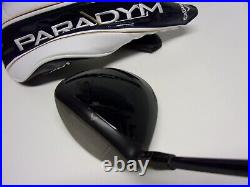



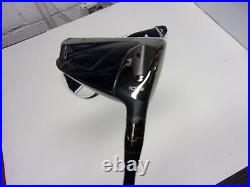

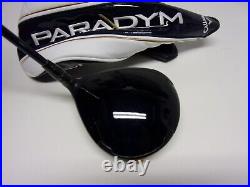



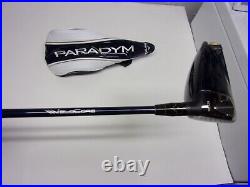
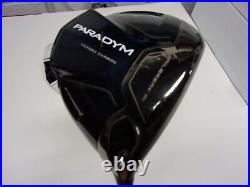
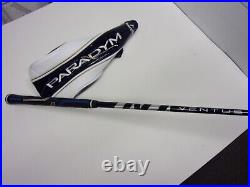


Minus length- this driver measures about 43 1/2. The Callaway Paradym driver has very impressive forgiveness. Sliding weight does a lot to change feel and dispersion. When it comes to introductions, Callaway couldn’t have scripted a better one for their new Paradym driver. In the first three weeks of the 2023 PGA Tour season, it’s been the only driver in the winner’s circle. But is this technological marvel only made for the likes of Jon Rahm? Not at all – this is a driver every golfer will want in their bag. The most eye-catching thing about the Callaway Paradym driver is the blue that covers most of the head. When I saw early pictures, I was a bit skeptical, worried that it would be too much. When I got it in hand, I saw that it is much more subdued. In bright sun, the blue does pop, but it’s dark enough that it doesn’t look like a toy. The texture of the blue, particularly on the sole, is unique and visually engaging. At address, the standard Paradym driver has a very nice shape. It’s not overly large in any dimension, and it’s nearly symmetrical. It hits a sweet spot where better players and high handicappers alike will feel confident standing over it. I particularly like how the matte blue front edge holds your focus right next to the ball. Both on the sole and in the playing position, Callaway demonstrates their mastery of adding a lot of details without making the club look busy. At address, there’s the blue carbon and also matte elements at the front and back. On the sole, there’s a sliding weight, bold Paradym branding, and technology callouts, but it’s all kept in balance. I’ve been saying this for several years, and I think it’s still true: no one tops Callaway when it comes to the aesthetics of a modern driver. The Paradym driver threads the needle by having an impact sound that’s distinctive without being obnoxious. It’s a poppy “thwack” that’s average in volume and mid-pitch. Additionally, it’s extremely consistent. At the launch event, I listened to literally hundreds of shots and was not able to distinguish a pure strike from a miss. Through the hands, the Paradym is very solid. Your hands also are responsible for delivering most of the feedback. This driver is very stable, so you will need to pay attention if you want to precisely locate your impact point. My first experience with the Callaway Paradym driver put its forgiveness to the test. I’d barely swung a driver in two months, and I had been standing or on a plane for the last ten hours. Despite the deck being stacked against it, the Paradym showed off the 15% improved dispersion that Callaway is touting. I was all over the club face, but every shot was playable and several were laser straight. When I got my own Paradym driver in hand for more testing, the forgiveness was even more impressive. I continued to see the same tight dispersion, but I got to put numbers to the standout ball speed. Every shot that I hit near the center of the face produced a smash factor of 1.48 or better. When I wandered out toward the toe or heel, I was still in the mid 1.4s! Between the consistency of the sound and ball speed, your playing partners may think you never miss the center of the face. All of this forgiveness is powered by three key technologies. The first is a 360° Carbon Chassis. Callaway uses no titanium in the body of the Paradym giving them extra weight to position for ball speed and stability. Second is the new Jailbreak system. It’s 33% lighter than the previous version while still adding ball speed to off-center strikes. Finally, Callaway continues to use AI to design their club faces. This makes them faster across all strikes and tightens dispersion. In all the talk about the ball speed and forgiveness, an element that’s slid under the radar is the sliding weight. This 15 gram weight made a significant impact in my testing. First, moving it from center to extreme toe or heel markedly changed how the club felt. Even more important, is the way is changed the dispersion. During one test session, I was hitting shots that were strong draws/borderline hooks. Sliding the weight to the toe cut the curvature in half, making most shots pleasant baby draws. Finally, I found the Callaway Paradym driver to be mid launch and spin. With the 9 degree head, I was launching the ball between 12 and 13 degrees on most shots with spin in the mid to low 2000s. As expected, both launch and spin were quite robust. Callaway is offering four stock shafts from Fujikura, Aldila, and Project X so you can find the feel, launch, and spin that work best for your swing. The Callaway Paradym driver can’t guarantee you a top finish on the PGA Tour, but it can help you find the fairway more often. This driver is a technological wonder – long, consistent, and straight. Make sure to get it fit to your swing, and you may enjoy your best season off the tee. The Fujikura Ventus is extremely accurate. Consistently high ball speed. Among the lowest spinning shafts I’ve ever hit. Watch this video of Fujikura’s employees explaining the benefits of Ventus, and you’ll quickly understand that they’re not holding back with the claims of what this shaft can do. Among the benefits they list are more centered contact, faster ball speed, and tightened dispersion. Can one shaft possibly confer all those advantages? I eagerly put it into my driver to find out. The Fujikura Ventus has an all-business look that lets the performance do the talking. Its dark navy color is interrupted only by the silver branding in the upper half of the shaft and the small “VeloCore” symbol near the tip. The Ventus logo has a crisp, futuristic look. When I looked at the EI Profile and then swung the Ventus, I felt as if Fujikura had designed it just for me. My feel preferences in a shaft tend toward a stable tip with a softer butt and mid. In the Ventus, Fujikura gave me more of everything I like. The tip of the Ventus is described as “ultra stiff” to prevent twisting. EI Profiles show that the tip of the Ventus is slightly stiffer than the ATMOS Black. At impact, the Ventus feels supremely stable, even on toe or heel shots. In the butt section, the Ventus is a little softer than the ATMOS Black and Speeder Evolution IV which leads to a slightly smoother feel. As is typical of Fujikura’s Speeder shafts, there isn’t a big kick but rather a smooth energy transfer from your hands through the shaft. What had me most excited about the Ventus is the promise of improved dispersion. Yes, I’d love more distance, but what I need is to play fewer shots from the trees. Right out of the gate, the Ventus delivered. My dispersion was much tighter than normal – perhaps the best I’ve ever had for a review – and two things in particular stood out. First, I had to really work to produce a shot that curved left. In all my testing, I didn’t hit a single ugly hook (I really hope I didn’t just jinx myself). Additionally, the ball didn’t want to bend much in either direction. Even with a wonky, Bubba-cut swing, the ball gently fell to the right. Did the Ventus also improve my ball speed and center face contact? My swing speed is down a bit (shoulder trouble), but my smash factor was as consistently high as it’s ever been. Translation: more ball speed and more distance. For me, the Ventus was mid-low launching with extremely low spin. In fact, the spin was so low I sometimes dropped below optimal. However, the dispersion is so tight, I will probably fix the spin with a higher lofted head rather than abandon this shaft. To close, I want to be clear that the Ventus is an awesome fit for me. In terms of feel and profile, it’s everything I like. This is an amazing shaft, but it’s not going to fit every player, and if it doesn’t fit you, you won’t see results like mine. As always, work with a club fitter to find your optimal fit. The Fujikura Ventus is available in 50, 60, 70, and 80 gram weights. The lightest version is offered in R2, Regular, and Stiff. Regular, Stiff, and X are the flex options at 60 grams. The heavier options are available in only Stiff and X. When I first saw Ventus at the PGA Show, I was excited to try it. As I watched the rapid adoption of Ventus on the PGA Tour, my anticipation grew to levels that I was afraid couldn’t be met. When I got it in hand, the Fujikura Ventus exceeded my highest hopes. This shaft is the clear front runner to go in the bag this year and has given me real hope for turning driving into a strength of my game.

